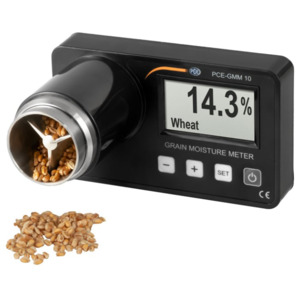
- Description
- Specifications
- Documents
- Measures 18 types of grain; Wheat, corn, Japonica rice, Indian rice, soybeans, rice, sorghum, rapeseed, millet, peanuts, barley, sunflower seeds, coffee beans, cocoa beans sesame, linseed/flaxseed, almonds, cashew
- Small sample size: About 65 ml
- Repeatability: 0.2%
- Adjustment range: ± 9.9%
- Automatic temperature compensation
- Manual measured value correction possible
- LCD display
Grain is a staple food for humans and animals. Among other things, it is also used as a raw material for the production of luxury foods such as spirits. Only high-quality grain can be processed and sold profitably. A decisive factor is the moisture content in the grain, it provides important information about its quality. The grain moisture meter from was specially designed to precisely and reliably determine the moisture content in 18 different types of grain. The measurement of the moisture content is essential for the storage, shelf life, and quality of cereals. If the moisture content is too high or too low, many types of grain cannot be processed optimally. Each operator who deals with the grain knows, that the permissible limits for moisture content should not be exceeded, otherwise it is impossible to send the whole crop to the storage facility and forward it further for processing.
A certain amount of moisture is always present in the grain, and depending on the weather conditions, its readiness for harvesting, the process of harvesting, type of the crop, this value may vary from one crop to another. Application of the grain moisture meter, capable of measuring moisture amount in different crops is very advantageous here since it is just necessary to switch to the required mode.
Therefore, care and monitoring of grain are essential before, during, and after storage. An ideal auxiliary tool is the grain moisture meter from PCE Instruments. With the support of the grain moisture meter, the moisture can be measured easily, comfortably, and particularly precisely and thus protect the grain from spoilage. Since the grain moisture meter can determine the moisture content directly in the field, the user can decide on-site whether the right time for harvest has come.
When it goes to materials of organic origin, it is necessary to take into consideration how much they are dependent on the environmental parameters (temperature, humidity). Wrong storage conditions may cause the development and growth of harmful bacteria, trigger rotting processes, and spoilage, mold formation. All these factors lead to the loss of the crop and big financial failures. To prevent this from happening, the regular and accurate measurements are required. Just in a very short time, a grain moisture meter is capable of providing its operator with the necessary information, which is presented on the screen of the device.
Equilibrium moisture / Drying options
The farmer always tries to possibly reduce the grain loss during threshing, at the same time he wants to drive the combine very quickly in order to harvest from as many hectares and grain area as possible. On the other hand, the absolute moisture in the harvested grain is crucial for the storage process. In the evening or, of course, when it rains, the moisture content in the grain is too high to continue harvesting.
Why is the moisture in the cereal / grain crucial?
In order to store wheat, corn, millet, and other types of grain without the grain being damaged, it must first be dried. Grain can only be stored when the moisture content reaches to a maximum of 14.5 percent. However, it is often harvested while the weather is quite wet. A subsequent drying process is therefore essential. If the grain contains too much moisture during storage, there is a risk of fungal attack, which makes it unusable. The moisture of the grain can be determined quickly and easily with the grain moisture meter from PCE Instruments, a whole grain moisture meter. Basically, the drier the grain is, the less likely it is that bacteria and fungi will spread. With the help of the grain moisture meter, it is possible to avoid the risks of reaching the so-called critical value of the humidity in the grain. That is exactly the stage when the grain or any other crop may start “living”, for example, the sprouts may appear and numerous microorganisms develop with an extreme acceleration, and as a result, the temperature rise inside the grain batch happens. It will be fair to mention, that there are many ways of moisture determination in the grain and other crops, but the application of the portable and easy-to-operate moisture detecting device has become so popular due to its simplicity, accuracy, and possibility to carry out the measurements anytime when it is necessary.
The measuring range of the grain moisture meter is large and is between 4.5 and 40 percent depending on the grain type. The drying systems for grain are only used for short periods of time during the year; of course, they consume energy and require maintenance. Therefore, the farmer would like to harvest the grain with the correct moisture content in order to avoid an additional drying process. This applies above all to the short-term storage of the grain. In the case of long-term storage, a recurring measurement of the grain moisture must be carried out in order, for example, to keep the equilibrium moisture in the grain for as long as possible over a storage period of 1-2 years. This also depends on the external conditions of the grain storage (outside temperature and humidity). The differences in moisture and storage conditions may also occur depending on the location. But attention must be paid to the fact that if the grain is over-dried, it shrinks and the farmer receives less money for his product – he usually also sells a certain amount of water to the processing company.
So there are two situations, in which the farmer is interested in measuring the moisture content of the grain with the help of the measuring device: during harvesting and during storage. In both cases, the grain moisture meter from PCE Instruments guarantees highly precise measurements.
The grain moisture meter only requires a very small sample volume of around 65 milliliters to determine the moisture content. The grain sample is filled into a small measuring container of the grain moisture meter to determine the moisture content. The container can be cleaned quickly and easily after use. A crushing of the grain is not necessary to measure the moisture content. The grain moisture meter automatically performs temperature compensation during the measurement. The grain moisture meter presents the well-legible measurement results on the large LC display. It is absolutely easy to use the battery-operated grain moisture meter via just four buttons. To protect the battery, the grain moisture meter automatically switches to sleep mode after three minutes of non-use. In addition, the grain moisture meter has a practical adjustment option to recalibrate the device. It is important, since in order to guarantee the reliability of the grain moisture meter, the user should calibrate and check the device at regular intervals.
ISO calibration
An ISO calibration certificate for the grain moisture measuring device certifies the traceability to the national test standards and is often required for compliance with DIN ISO 9000. The measuring device is adjusted and calibrated and the certificate issued in the name of the customer confirms compliance with the properties specified by PCE Instruments. The calibration intervals for the moisture measuring device are determined in the in-house ISO manual.
Areas of application
The user-friendly grain moisture meter is ideally suited for a reliable determination of moisture in 18 different types of grain. The compact and handy design and the battery operation of the grain moisture meter guarantee a flexible and location-independent use. The moisture content can be determined using a grain moisture meter, for example, during the harvest in the field. The grain moisture meter is ideal for determining important indicators of grain storage and quality. The grain moisture meter from PCE Instruments is also an important tool for growing cereals, in mills, granaries or in the processing industries of cereals and legumes.
What's in the Box
- 1x Grain Moisture meter PCE-GMM 10
- 1x Carrying case
- 1x Cleaning brush 1x Screwdriver
- 1x 9V Block battery 1x User Manual
